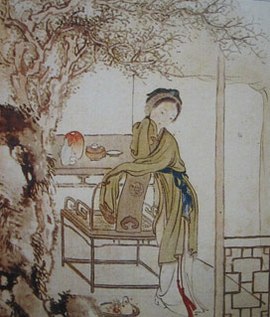Dream of the Red Chamber

Dream of the Red Chamber, also called The Story of the Stone, or Hongloumeng (traditional Chinese: 紅樓夢; simplified Chinese: 红楼梦; pinyin: Hónglóumèng), composed by Cao Xueqin, is one of China’s Four Great Classical Novels. It was written some time in the middle of the 18th century during the Qing dynasty. Long considered a masterpiece of Chinese literature, the novel is generally acknowledged to be one of the pinnacles of Chinese fiction.[1] “Redology” is the field of study devoted exclusively to this work.[2]
The title has also been translated as Red Chamber Dream and A Dream of Red Mansions. The novel circulated in manuscript copies with various titles until its print publication, in 1791. Gao E, who prepared the first and second printed editions with his partner Cheng Weiyuan (程偉元) in 1791–92, added 40 additional chapters to complete the novel.[3]
Red Chamber is believed to be semi-autobiographical, mirroring the rise and decline of author Cao Xueqin’s own family and, by extension, of the Qing dynasty.[4] As the author details in the first chapter, it is intended to be a memorial to the women he knew in his youth: friends, relatives and servants. The novel is remarkable not only for its huge cast of characters and psychological scope, but also for its precise and detailed observation of the life and social structures typical of 18th-century Chinese society.[5] It contains within its pages a sampling of all of the major modes of the Chinese literary tradition.[6]
The novel is composed in written vernacular (baihua) rather than Classical Chinese (wenyan). Cao Xueqin was well versed in Chinese poetry and in Classical Chinese, having written tracts in the semi-wenyan style, while the novel’s dialogue is written in the Beijing Mandarin dialect, which was to become the basis of modern spoken Chinese. In the early 20th century, lexicographers used the text to establish the vocabulary of the new standardised language and reformers used the novel to promote the written vernacular.[7]
Dream of the Red Chamber’s textual history is involved and complex, and has long been a subject of critical scrutiny, debate, and conjecture.[8] It is known that Cao Xueqin, a member of an eminent family that had served the Qing dynasty emperors but whose fortunes had begun to decline, began writing Dream of the Red Chamber during the 1740s.[9] By the time of his death in 1763 or 1764, Cao had completed the first 80 chapters of the novel and might have made early drafts of the remaining chapters.[10] The first 80 chapters circulated during Cao’s lifetime in hand-copied manuscripts, first among Cao’s personal friends and a growing circle of aficionados, then eventually on the open market where they sold for large sums of money.[8][11] The first printed version, published by Cheng Weiyuan and Gao E in 1791, contains edits and revisions not authorized by the author.[3] It is possible that Cao destroyed the last chapters[12] or that at least parts of Cao’s original ending were incorporated into the 120 chapter Cheng-Gao versions,[13] with Gao E’s “careful emendations” of Cao’s draft.[14]
